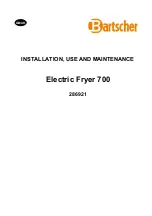
WVM_BASIS_EN_03—07/2016
23
Intake socket for regeneration air
A supply air duct or a supplying pipe can be flanged to the dryer by way of the
intake socket to guide regeneration air to the dryer (see page 26).
Intake filter for regeneration air
The intake filter removes solid impurities (e.g. dust) from the regeneration air
before it reaches the dryer.
The intake filter is flange mounted and can therefore only be installed in
conjunction with a intake socket (see before).
Loop regeneration (loop cooler)
The desiccant absorbs the moisture in the ambient air during the cooling phase.
The amount of moisture taken in can be accordingly high at very high ambient
temperatures and relative humidity (e.g. in tropical operating environments).
A loop cooler can be implemented in order to prevent this situation and to ensure
a stable pressure dewpoint under above mentioned adverse circumstances. This
principle implies taking in the regeneration air only once and then circulating it.
The heat dissipates via a water cooled heat exchanger.
The operator must provide a cooling water connection and appropriate cooling
water valves.
Note:
The heat exchanger choice depends on the quality of the cooling
water. For this purpose, you should contact the dryer manufacturer
beforehand.
Steam heat exchanger
To heat the regeneration air, a steam heat exchanger can also be used as an
alternative to the standard electric heater. The steam heat exchanger comes with
an appropriate steam shut-off valve.
In this case, the scope of delivery can also comprise supplementary documents
such as data sheets or supplementary operating manuals.
Steam/electric heater combination
In this option, the existing electric heater is supplemented by an additional steam
heat exchanger. This allows for three operating modes:
Pure steam operation
Sufficient hot steam is available for regeneration. The electric heater is not
needed.
Pure electric operation
Hot steam is not available, the electric heater performs all the heating.
Combination operation
The heating capacity of the steam heat exchanger is not sufficient to reach the
required regeneration temperature. As a consequence, the electric heater is
turned on to compensate for the temperature deficit.
















































